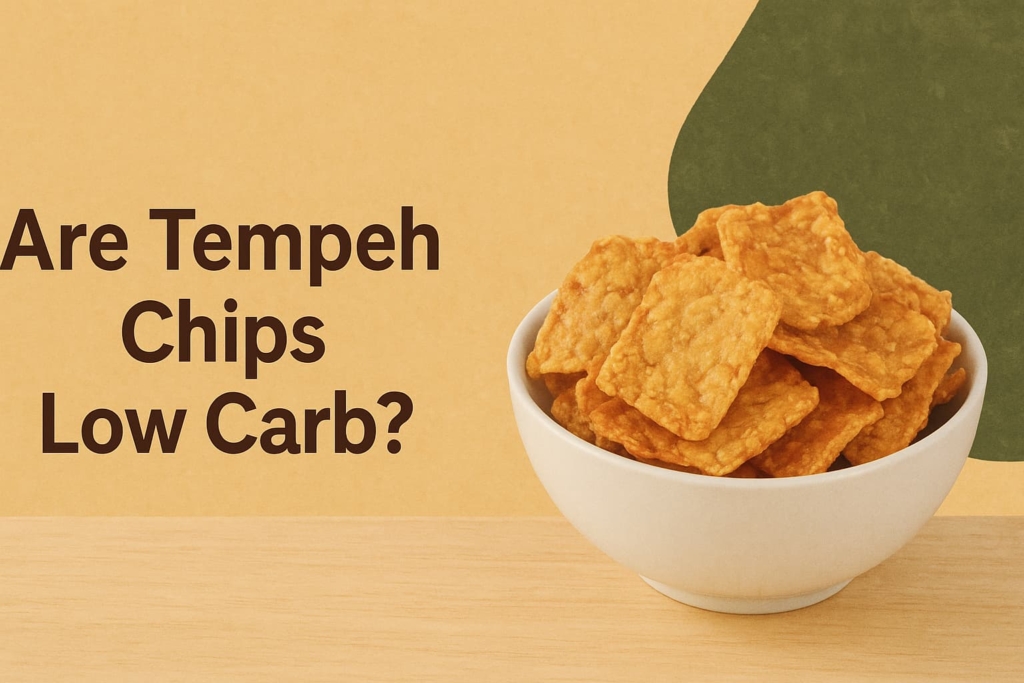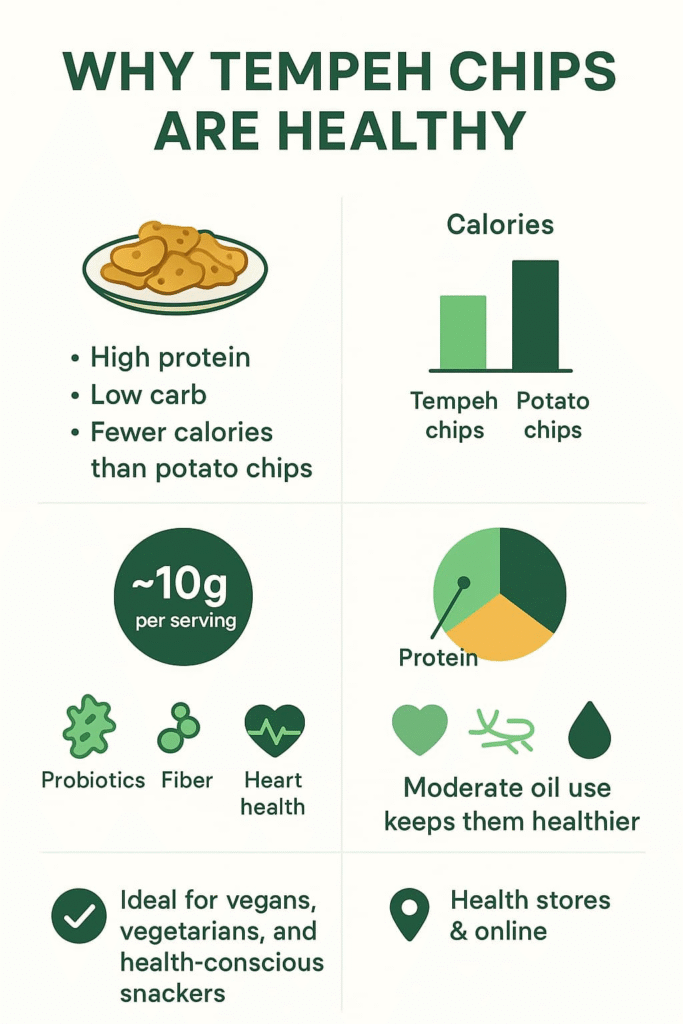Why tempeh chips are healthy snacks you should try today? Find out how they fuel your body with protein, fiber, and delicious crunch. Those thin, crispy tempeh chips that keep showing up in health food stores aren’t just another trendy snack. They’re actually worth checking out. Made from fermented soybeans (yeah, that’s what tempeh is), these crunchy bites pack about 15 grams of protein per serving – way more than those potato chips sitting in your pantry right now.
They’re pretty much everything you’d want in a snack: salty, crunchy, and they won’t wreck your diet. Plus, they’ve got this great mix of fiber and good bacteria that’s probably better for your gut than whatever else you’re munching on. Stick around to find out why these chips might be exactly what your snack drawer’s been missing.
Key Takeaways
- The crunchy tempeh chips pack about 15 grams of plant protein per serving, along with a generous dose of B-vitamins that you’d probably miss out on with typical snacks.
- These fermented soybean treats give your gut what it needs, thanks to all those good bacteria doing their thing during the traditional aging process.
- SoyaMaya’s tempeh chips might cost a bit more, but they’ve got half the calories of regular chips and won’t leave you feeling guilty about snacking.
What Makes Tempeh Chips a Healthy Snack
Those store-bought potato chips don’t stand a chance against this Indonesian-inspired munchie. Tempeh chips start with something pretty basic – fermented soybeans that pack way more punch than you’d think. The whole fermentation thing actually creates these good bacteria (scientists call them probiotics) that keep your stomach happy.
The best part? A handful of these crunchy bits (about 30 grams if you’re counting) gives you as much protein as a small egg – somewhere between 10 to 15 grams. That’s similar to the boost you’d get from tempeh protein chips that focus on keeping snacks filling and nutrient-rich. Plus there’s all this fiber that keeps your blood sugar from going crazy. What else you’re getting:
- B vitamins and vitamin K for energy
- Calcium and iron (more than those other snacks)
- Zero cholesterol, no weird fats
- Usually fried in coconut oil or olive oil (except SoyaMaya – they use avocado oil)
Look, nobody’s saying tempeh chips are going to solve world hunger, but they’re definitely a step up from those grease-soaked alternatives sitting in your pantry right now. They’re basically what happens when healthy food actually tastes good.
Are Tempeh Chips Better Than Potato Chips?
Look around any grocery store, and you’ll spot shelves stacked with potato chips – those crispy, salty snacks that we all know aren’t doing our bodies any favors. A typical serving (about 15 chips) packs around 10 grams of fat and enough sodium to make your doctor cringe. Plus, they’re basically just empty calories that’ll have you reaching for more in an hour.
But here’s something different: tempeh chips. These crunchy bits (made from fermented soybeans) pack a real nutritional punch, with only 5 grams of fat per serving and way less salt than their potato cousins. Some options even come with unique twists like tangy garlic for those who want bold flavor without losing the health perks. SoyaMaya’s tempeh chips even managed to nail that satisfying crunch without dumping in extra oil – a pretty neat trick.
The best part? Tempeh chips don’t send your blood sugar on a roller coaster ride like potato chips do. They’re loaded with protein (about 8 grams per serving) and fiber that actually keeps you full for more than 20 minutes. No cholesterol either, which is probably worth mentioning to that friend who’s always talking about their heart health.
So yeah, tempeh chips might cost a bit more, but they’re probably worth it if you’re tired of feeling guilty about your snack choices.
How Many Calories Are in Tempeh Chips?
Tempeh chips pack some serious punch in a small handful. A serving – that’s about 25 grams or a decent palmful – comes in at 130 calories. Not bad for a snack that’s got some actual nutrients behind it. Here’s what you’re getting in each serving:
- 9g of fat (mostly from good stuff like coconut oil)
- 12g of protein (that’s pretty decent for a chip)
- 8g of carbs
- 3.5g fiber
SoyaMaya’s version runs a bit higher at 150 calories per serving, but they’re a bit more generous with their portions. The protein content makes these chips filling enough that you probably won’t eat the whole bag in one sitting. Most people don’t need the nutrition facts drilled into their heads, but it’s worth knowing these numbers if you’re keeping track of what goes into your body.
These chips don’t have any of that sketchy stuff – no trans fats, no cholesterol. Sure beats mindlessly munching on empty calories. Just remember that “healthy” doesn’t mean you can eat the whole bag – portion control still matters, even with the good stuff.
What Is the Protein Content in Tempeh Chips?
Tempeh chips pack a decent protein punch, thanks to those fermented soybeans they’re made from. A 2-ounce serving (about 15-20 chips) gives you roughly 12 grams of protein – that’s pretty good for something that looks like a regular snack.
Most SoyaMaya chips have between 10-15 grams per bag, though the exact amount might vary a bit depending on how they’re made. The real kicker is that unlike those empty-calorie snacks sitting in your pantry, these actually fill you up. The protein keeps blood sugar from going crazy, and it’s probably why you don’t end up eating the whole bag in one sitting.
People who don’t eat meat seem to love these things, and it makes sense – they’re always looking for protein that isn’t another smoothie or bar. Plus, the fermentation process (which takes about 24-36 hours) makes the protein easier to digest, so your stomach won’t hate you later.
These aren’t your average chips. They’re what happens when someone decides regular snacks need more muscle-building power. For anyone counting: a serving usually runs around 160 calories, with those 12 grams of protein making up a good chunk of that.
Are Tempeh Chips Low Carb?

Tempeh chips pack way less carbs than your standard snacks, usually hitting around 3-12 grams in each serving. Not bad, right? And here’s what’s cool – a decent chunk of those carbs come from fiber, which means they won’t send your blood sugar through the roof like some other munchies might.
People watching their carbs (diabetics, keto folks) don’t have to stress too much about grabbing a handful. Most brands, except maybe SoyaMaya which runs a bit higher at 15g per serving, keep things pretty reasonable. The fiber in these crunchy bits does the heavy lifting – it’s like a traffic cop for your digestion, slowing everything down so you don’t get that annoying sugar rush and crash.
Sure, they’re processed food (I mean, what isn’t these days?), but they’re definitely not in the same league as those carb bombs sitting in most people’s pantries. Just remember to check the nutrition panel since some companies like sneaking in extra stuff that can bump up the carb count.
Nutritional Breakdown of Tempeh Chips
Most people don’t know this, but tempeh chips pack way more than just a satisfying crunch (1). A regular handful (that’s about 30 grams) brings some serious nutrition to the table:
- Fat: 8-11 grams – don’t worry, it’s mostly the good stuff from coconut and olive oils. SoyaMaya’s version uses a bit less oil than others, keeping the saturated fat down.
- Fiber: 3-4 grams – enough to keep things moving, if you know what I mean.
- Vitamins: B12 and B6 are the stars here, plus vitamin K that’s pretty hard to find in snack foods (it’s the one that helps your blood clot properly and keeps your bones strong).
- Minerals: Iron for energy, calcium for bones, and magnesium that helps with basically everything. There’s also potassium and phosphorus thrown in there.
- Extra perks: The fermentation process creates some helpful compounds – antioxidants and probiotics that boost your immune system and fight inflammation.
So yeah, these aren’t your average empty-calorie chips. They’re actually doing something useful while they’re hanging out in your system. Pretty neat for something that just feels like you’re eating junk food.
What Are the Health Benefits of Tempeh Chips?
The numbers printed on SoyaMaya’s tempeh chips might look like gibberish, but they pack quite a punch for your health. These crunchy little snacks do more than just satisfy those afternoon cravings:
- Gut Health: The fermentation process creates this perfect storm of good bacteria – probiotics that keep your stomach happy and prebiotics that feed those helpful microbes. Less bloating, better digestion. Simple as that.
- Weight Management: Each handful gives you protein and fiber that stick with you longer than regular chips would. You won’t be reaching for more snacks an hour later.
- Heart Health: Your heart’s gonna love these – they’ve got potassium (about 300mg per serving) and healthy fats that help keep blood pressure in check.
- Blood Sugar Control: Unlike those other snacks that send your sugar levels on a roller coaster ride, these chips take it nice and slow. Pretty handy if you’re watching your glucose.
- Anti-inflammatory Properties: There’s something about fermented soybeans that helps calm down inflammation in your body. The science isn’t perfect on this one yet, but the early signs look good.
Are Fried Tempeh Chips Still Healthy?

Deep frying isn’t usually good news for health-conscious folks, but with tempeh chips, things get interesting. These crispy soy snacks might actually keep some of their good stuff intact, especially when they’re fried in coconut oil (which actually does something useful in your body instead of just hanging around like other fats).
Sure, frying adds extra calories – that’s just physics. But tempeh chips still pack quite a bit of protein, and they’re way better than those greasy potato chips collecting dust in your pantry. SoyaMaya makes their chips with coconut oil, which probably explains why they don’t leave that gross feeling in your mouth. A serving (about 1 ounce) typically contains:
- 160-180 calories
- 8-10g protein
- 6-8g healthy fats
- 2g fiber
Look, nobody’s saying fried tempeh chips are some kind of miracle health food. But they’re not exactly junk either. Just don’t eat the whole bag at once, and maybe skip the ones with weird oils you can’t pronounce. Better yet, grab some baked ones if you’re counting calories. Makes sense, right?
Who Should Eat Tempeh Chips?
These nutty, crunchy snacks work great for plenty of people:
- Health nuts looking for something better than those greasy potato chips
- Plant-based eaters who need their protein fix (each serving packs about 15g)
- People who can’t do gluten but still want something crispy
- Anyone trying to keep their blood sugar steady
- Folks tired of the same old snacks at work
Just a heads up – tempeh chips probably aren’t the best pick if you’ve got soy issues or thyroid problems. The soy content might mess with your thyroid meds, and there’s really no way around that since these chips are basically all soybean (except for SoyaMaya’s new chickpea version).
For everyone else though? Go for it. They’re pretty filling, and you won’t get that gross oily feeling you might get from regular chips. Plus they actually have some decent nutrition – kind of like eating a handful of roasted soybeans, just crunchier (2).
Where to Find Healthy Crunchy Snacks Like Tempeh Chips

Those crunchy little tempeh chips seem to be popping up everywhere these days. Gone are the times when you’d need to trek across town to that one health store that might have them. Between natural food shops, bigger grocery chains, and a bunch of online sellers (including SoyaMaya’s pretty decent online store), there’s no shortage of options. What to check for on those labels:
- The usual vegan and gluten-free stamps
- Non-GMO stuff, if that’s your thing
- Nothing artificial thrown in there
- Better oils like coconut or olive (none of that cheap stuff)
- Real fermented soybeans as the base, which is good for your gut
You might think plain old sea salt’s the only flavor out there, but there’s actually tons of different ones – some with herbs, others with a kick of heat. A classic pick that’s always popular is the light sea salt version, which keeps things simple while letting the natural tempeh taste shine. Not bad for a snack that won’t wreck your health goals. And hey, if one flavor doesn’t do it for you, there’s probably five more to try.
FAQ
What makes tempeh chips a better snack option than potato chips?
Tempeh chips are made from fermented soybeans, which give them a nutty taste and a boost of plant based protein. Compared to potato chips, they contain more vitamins and minerals, helpful plant compounds, and a source of protein that supports weight management.
This kind of healthy food can also help with cholesterol levels, bone health, and digestive health. Unlike typical snacks, a serving of tempeh delivers real health benefits, making tempeh chips one of the most balanced healthy snacks you can reach for.
Are tempeh chips safe for people with a soy allergy or sensitivity to soy products?
If you have a soy allergy, it’s best to avoid tempeh and any soy products, including tempeh snacks. Tempeh chips are made from fermented soybean, which means they contain soy protein, soy isoflavones, and other compounds found in soy products.
While fermentation introduces beneficial bacteria that can support gut health, the soy content itself does not change enough to make it safe for someone with an allergy. If you’re unsure, always check with a doctor before adding tempeh chips or any plant based snack option to your diet.
How do the health benefits of tempeh compare with other healthy snacks?
The health benefits of tempeh are tied to its base as a fermented soybean food, packed with plant based protein, vitamins and minerals, and protective plant compounds. Eating tempeh chips can support digestive health through beneficial bacteria, improve bone health, and even help manage cholesterol levels.
Some research suggests soy isoflavones may reduce oxidative stress, which helps your body stay strong. Compared with many other healthy snacks, a serving of tempeh offers more lasting energy and greater nutritional value, making tempeh chips a good food choice in everyday eating.
Why are tempeh chips considered part of traditional Indonesian food culture?
Tempeh comes from Indonesia, where fermented soybeans have been a staple for centuries. Tempeh chips, sometimes known as santap tempe chips, grew from this tradition and turned into a popular snack option. They carry the nutty taste of fermented soybean while delivering health benefits linked to soy protein and plant based eating.
This makes them more than just a crunchy treat; they’re a healthy food rooted in cultural heritage. Adding a little sea salt highlights their flavor while keeping them simple, plant based, and full of the same qualities that make tempeh a respected part of Indonesian food.
Conclusion
Soya Maya story twists through time like the roots of Indiana’s soybean fields. From a small Indonesian kitchen to Greensburg’s bustling food scene, they’ve turned local soybeans into something special – tempeh that’s both traditional and forward-thinking.
Every batch gets fermented the old-school way, but with a modern touch (they’re the only ones in America adding B12). Their tempeh chips? They’re what happens when you take those same premium soybeans and turn them into something you’d actually want to snack on.
Ready to try something different? Check out Mayasari’s tempeh and chips – straight from Indiana’s heartland to your kitchen.
References
- https://www.nutritionvalue.org/public_recipe_172933.html
- https://foods.fatsecret.com/calories-nutrition/usda/tempeh

